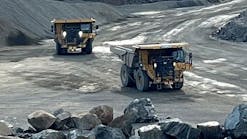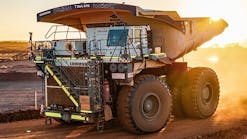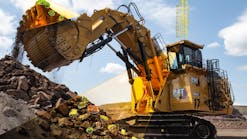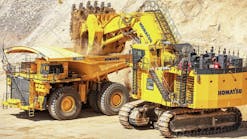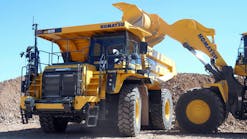Autonomous Mining Trucks Approach Milestone
The company has equipped its 830E, 930E, and 980E mining haul trucks to operate autonomously, completing cycle after cycle without operators in the cab. They’re at work in the oil sands of Canada, with Codelco in Chile, and in mines in Australia.
Komatsu targets four applications with its system: oil sands, copper, iron, and coal.
Typically, one or two operators work in a control center to monitor the vehicles as they are loaded and run haul-and-dump cycles at mines and quarries. An occupied pickup truck is also roaming the area monitoring the action, and all light vehicles at a work site are equipped with monitors that show the haul vehicles’ locations.
Right now, WiFi and satellites are used for communication and positioning, but the company says it will be going to LTE soon for stronger, more consistent signals.
In a recent demo at Komatsu’s Arizona Proving Grounds in Sahuarita, Arizona, Construction Equipment observed four haul trucks simulating being loaded by a PC7000 mining shovel, and completing a run over haul roads to a dumping area. Two trucks can approach a shovel at one time, one on each side.
(Take a ride in the autonomous truck with Senior Editor Frank Raczon, below.)
They can pass each other on the haul road, when authorized, as every truck has a security perimeter around it that will immediately stop the truck when an object or vehicle comes too close. It appears to be a smooth, efficient operation.
Komatsu says the load and haul unit cost for users of its Autonomous Haulage System (AHS) are reduced by up to 15 percent, and there’s a 13 percent reduction in overall maintenance.
Also, the optimized automatic controls reduce sudden acceleration and abrupt steering, resulting in a surprising 40 percent improvement in tire life compared to manned operations.
“There is simply no human variability in operations,” says Brian Yureskes, director, Sales & Global Accounts, Komatsu America.
Komatsu is busy refining its futuristic Innovative Autonomous Haulage Vehicle (IAHV), which was previewed during the last MINExpo, aiming to further streamline the AHS process.
The IAHV, now cloaked in relative secrecy (photography was forbidden) in a large shop at the Proving Grounds, is designed to haul in both forward and reverse, eliminating the need for K-turns during the loading and unloading process. Loads will be distributed evenly to four wheels, and through four-wheel-drive, retarder and steering, higher speed hauling will be possible.


